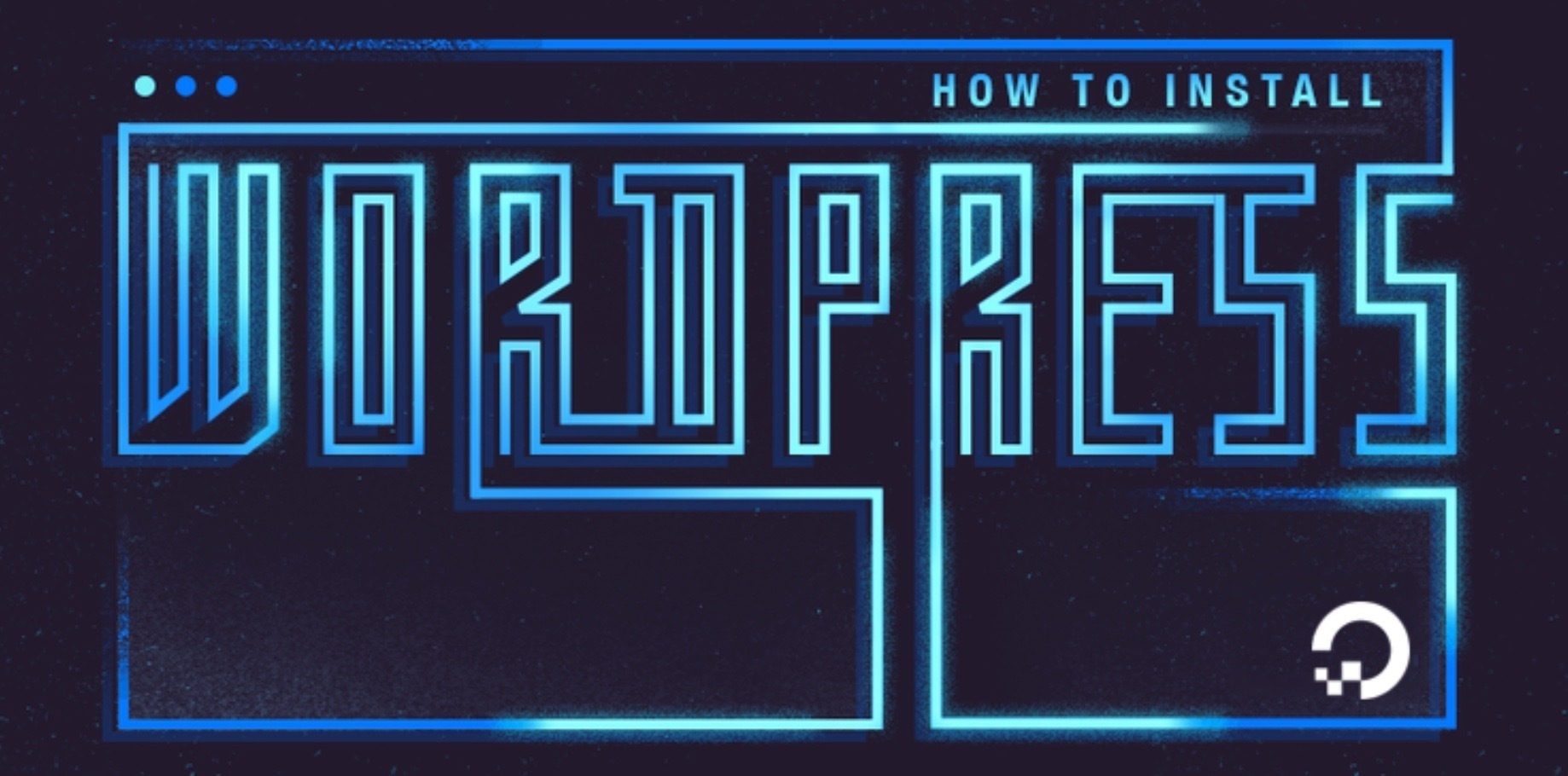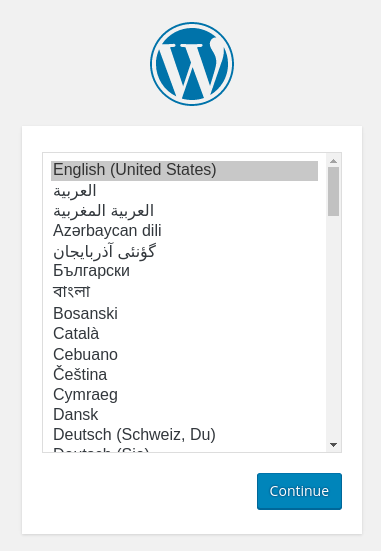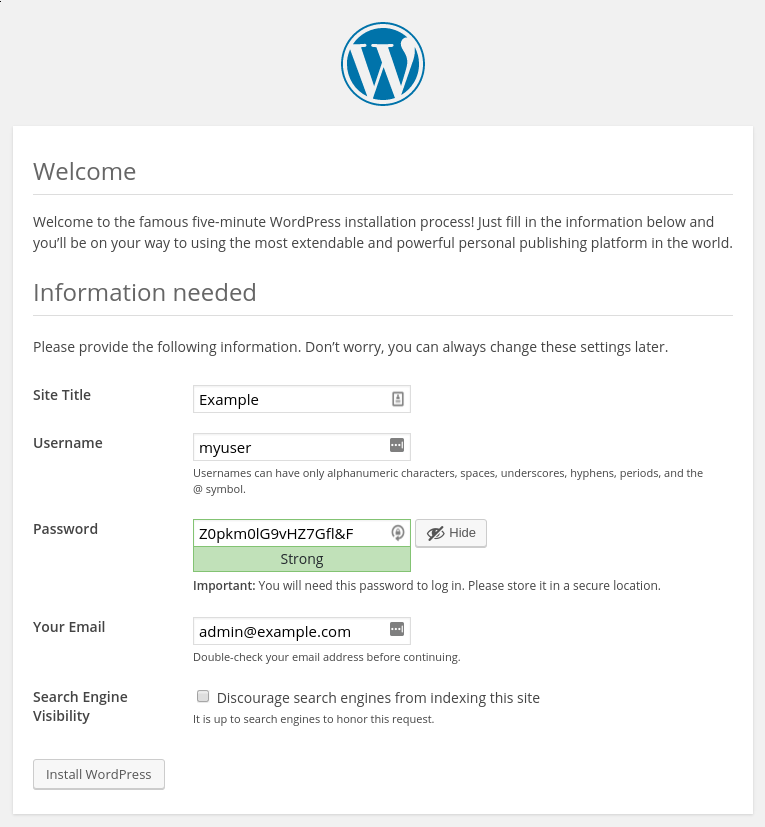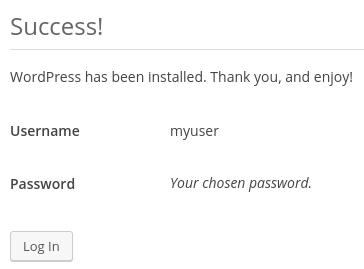- Log in to:
- Community
- DigitalOcean
- Sign up for:
- Community
- DigitalOcean
Not using Ubuntu 22.04?
Choose a different version or distribution.
Introduction
WordPress is a popular, open-source content management system (CMS) that allows users to create, customize, and manage content on their website. A CMS provides the basic infrastructure to build a website, which is useful for users who may not have the knowledge to build and code their own website from scratch. The WordPress CMS has many customization tools, such as an administrative dashboard with a user-friendly interface to create new web pages, add media, and more. For these reasons, WordPress is one of the most used CMS in the market today.
There are many different approaches to getting access to WordPress, but some setup processes are more complex than others. This tutorial is intended for those who desire to install and administer a WordPress instance on an unmanaged cloud server via the command line. Though this approach requires more steps than a ready-made WordPress installation, it offers administrators greater control over their WordPress environment.
This tutorial will be using a LAMP (Linux, Apache, MySQL, and PHP) stack, which is one option for a server architecture that supports WordPress by providing the Linux operating system, Apache web server, MySQL database, and PHP programming language. We’ll install and set up WordPress via LAMP on a Linux Ubuntu 22.04 server.
Depending on your needs and goals, you may find other options that are more suitable. As open-source software, WordPress can be freely downloaded and installed, but to be available on the web, you will likely need to purchase cloud infrastructure and a domain name. Continue following this guide if you are interested in working through the server-side installation and setup of a WordPress site.
If you are looking to access a ready-made WordPress installation, DigitalOcean Marketplace offers a one-click app to get you started with WordPress through installation when spinning up your server.
Prerequisites
To complete this tutorial, you will need:
- One Ubuntu 22.04 server set up by following the Ubuntu 22.04 initial server setup guide. Ensure you have a non-root
sudouser and firewall enabled. - A LAMP stack installed on your server. Follow our guide on How To Install Linux, Apache, MySQL, PHP (LAMP) stack on Ubuntu 22.04 to install and configure this software.
- Your site secured with TLS/SSL certificates. WordPress takes in user input and stores user data, so it is important for it to have a layer of security. TLS/SSL is the technology that allows you to encrypt the traffic from your site so that your and your users’ connection is secure. Here are two options available to meet this requirement:
- If you have a domain name you can secure your site with Let’s Encrypt, which provides free, trusted certificates. Follow our Let’s Encrypt guide for Apache to set this up.
- If you do not have a domain and you are just using this configuration for testing or personal use, you can use a self-signed certificate instead. This provides the same type of encryption, but without domain validation. Follow our self-signed SSL guide for Apache to get set up.
When you are finished with the setup, log into your server as your sudo user and continue to the first step.
Step 1 — Creating a MySQL Database and User for WordPress
The first step is a preparatory one. WordPress uses MySQL to manage and store site and user information. You have MySQL installed already, but need to make a database and a user for WordPress to use.
To get started, log into the MySQL root (administrative) account by issuing the following command (note that this is not the root user of your server):
- sudo mysql
Note: If you installed MySQL by following a tutorial other than the one listed in the prerequisites, you may have enabled password authentication for your root MySQL user. If so, you can connect to MySQL with the following command:
- mysql -u root -p
Within the database, create a dedicated database for WordPress to control. You can call this whatever you would like, but we will be using the name wordpress in this guide. Create the database for WordPress by running the following command:
- CREATE DATABASE wordpress DEFAULT CHARACTER SET utf8 COLLATE utf8_unicode_ci;
Note: Every MySQL statement must end in a semi-colon (;). Check to make sure this is present if you are running into any issues.
Next, you’re going to create a separate MySQL user account that you’ll use exclusively to operate your new database. Creating specific databases and accounts can support you from a management and security standpoint. We will use the name wordpressuser in this guide, but feel free to use any name you prefer for this use.
You can create this user by running the following command. Remember to choose a strong password here for your database user where we have password:
- CREATE USER 'wordpressuser'@'%' IDENTIFIED WITH mysql_native_password BY 'password';
Next, let the database know that your wordpressuser should have complete access to the database you set up:
- GRANT ALL ON wordpress.* TO 'wordpressuser'@'%';
You now have a database and user account, each made specifically for WordPress. You need to flush the privileges so that the current instance of MySQL knows about the recent changes made:
- FLUSH PRIVILEGES;
Exit out of MySQL by writing the following:
- EXIT;
In the next step, you’ll lay some foundations for WordPress plugins by downloading PHP extensions for your server.
Step 2 — Installing Additional PHP Extensions
When setting up our LAMP stack, we only required a very minimal set of extensions in order to get PHP to communicate with MySQL. WordPress and many of its plugins, however, leverage additional PHP extensions.
You can download and install some of the most popular PHP extensions for use with WordPress. But first, use the APT package management tools to update your local package index:
- sudo apt update
Then you can install the various PHP extensions for WordPress:
- sudo apt install php-curl php-gd php-mbstring php-xml php-xmlrpc php-soap php-intl php-zip
This will lay the groundwork for installing additional plugins on your WordPress site.
Note: Each WordPress plugin has its own set of requirements. Some may require additional PHP packages to be installed. Check your plugin documentation to discover its PHP requirements. If they are available, they can be installed with apt as demonstrated in the previous example.
You’ll need to restart Apache to load these new extensions. In the next section, you’ll make some more tweaks to Apache’s configuration, so you can wait until then, or restart now to complete the PHP extension process:
- sudo systemctl restart apache2
After you’ve restarted, or if you’re choosing to wait, you can continue to the next section to begin making adjustments to the Apache configuration.
Step 3 — Adjusting Apache’s Configuration to Allow for .htaccess Overrides and Rewrites
Next, you’ll be making a few minor adjustments to your Apache configuration. Based on the prerequisite tutorials, you should have a configuration file for your site in the /etc/apache2/sites-available/ directory.
In this guide, we’ll use /etc/apache2/sites-available/wordpress.conf as an example, but you should substitute the path to your existing configuration file where appropriate. Additionally, we will use /var/www/wordpress as the root directory of our WordPress installation. You should use the web root specified in your own configuration. If you followed our LAMP tutorial, it may be your domain name instead of wordpress in both of these instances.
Note: It’s possible you are using the 000-default.conf default configuration (with /var/www/html as your web root). This is fine to use if you’re only going to host one website on this server. If not, it’s better to split the necessary configuration into logical chunks, one file per site.
With your paths identified, you can move on to working with .htaccess so that Apache can handle configuration changes on a per-directory basis.
Enabling .htaccess Overrides
Currently, the use of .htaccess files is disabled. WordPress and many WordPress plugins use these files extensively for in-directory tweaks to the web server’s behavior.
Open the Apache configuration file for your website with your preferred text editor. Here, we’ll use nano:
- sudo nano /etc/apache2/sites-available/wordpress.conf
To allow .htaccess files, you need to set the AllowOverride directive within a Directory block pointing to your document root. Add the following content inside the VirtualHost block in your configuration file, making sure to use the correct web root directory:
<VirtualHost *:80>
. . .
<Directory /var/www/wordpress/>
AllowOverride All
</Directory>
. . .
</VirtualHost>
When you are finished, save and close the file. In nano, you can do this by pressing CTRL and X together, then Y, and ENTER.
Enabling the Rewrite Module
Next, you can enable mod_rewrite so that you can use the WordPress permalink feature:
- sudo a2enmod rewrite
This allows you to have more human-readable permalinks to your posts, like the following two examples:
http://example.com/2012/post-name/
http://example.com/2012/12/30/post-name
The a2enmod command calls a script that enables the specified module within the Apache configuration.
Enabling the Changes
Before implementing the changes you’ve made, check to make sure you haven’t made any syntax errors by running the following test:
- sudo apache2ctl configtest
You may receive output like the following:
OutputAH00558: apache2: Could not reliably determine the server's fully qualified domain name, using 127.0.1.1. Set the 'ServerName' directive globally to suppress this message
Syntax OK
If you wish to suppress the top line, add a ServerName directive to your main (global) Apache configuration file at /etc/apache2/apache2.conf. The ServerName can be your server’s domain or IP address. This is just a warning message, however, and doesn’t affect the functionality of your site. As long as the output contains Syntax OK, you are ready to continue.
Restart Apache to implement the changes. Make sure to restart now even if you have restarted earlier in this tutorial:
- sudo systemctl restart apache2
Next, you’ll download and set up WordPress itself.
Step 4 — Downloading WordPress
Now that your server software is configured, you can download and set up WordPress. For security reasons, it is always recommended to get the latest version of WordPress from their site.
First, change into a writable directory (we recommend a temporary one like /tmp):
- cd /tmp
Then download the compressed release with the following curl command:
- curl -O https://wordpress.org/latest.tar.gz
Extract the compressed file to create the WordPress directory structure:
- tar xzvf latest.tar.gz
You’ll be moving these files into your document root momentarily. Before doing so, you can add a dummy .htaccess file so that this will be available for WordPress to use later.
Create the file by running the following:
- touch /tmp/wordpress/.htaccess
You’ll also copy over the sample configuration file to the filename that WordPress reads:
- cp /tmp/wordpress/wp-config-sample.php /tmp/wordpress/wp-config.php
Additionally, create the upgrade directory so that WordPress won’t run into permissions issues when trying to do this on its own following an update to its software:
- mkdir /tmp/wordpress/wp-content/upgrade
Now you can copy the entire contents of the directory into your document root. We are using a dot at the end of our source directory to indicate that everything within the directory should be copied, including hidden files (like the .htaccess file we created). Ensure that you replace the /var/www/wordpress directory with the directory you have set up on your server:
- sudo cp -a /tmp/wordpress/. /var/www/wordpress
You’re now ready to configure your WordPress directory.
Step 5 — Configuring the WordPress Directory
Before starting the web-based WordPress setup, you need to adjust some items in your WordPress directory.
Adjusting the Ownership and Permissions
Another important step is setting up reasonable file permissions and ownership for the files and directories WordPress uses to function.
Start by giving ownership of all the files to the www-data user and group. This is the user that the Apache web server runs as, and Apache will need to be able to read and write WordPress files in order to serve the website and perform automatic updates.
Update the ownership with the chown command which allows you to modify file ownership. Be sure to point to your server’s relevant directory:
- sudo chown -R www-data:www-data /var/www/wordpress
Next, run two find commands to set the correct permissions on the WordPress directories and files. This first find command sets every directory within the /var/www/<>^wordpress<^> directory and sets each one’s permissions to 750:
- sudo find /var/www/wordpress/ -type d -exec chmod 750 {} \;
This one finds each file within the directory and sets their permissions to 640:
- sudo find /var/www/wordpress/ -type f -exec chmod 640 {} \;
These permissions should get you working effectively with WordPress, but note that some plugins and procedures may require additional tweaks.
Setting Up the WordPress Configuration File
Now, you need to make some changes to the main WordPress configuration file.
When you open the file, your first task will be to adjust some secret keys to provide a level of security for your installation. WordPress provides a secure generator for these values so that you do not have to try to come up with good values on your own. These are only used internally, so it won’t hurt usability to have complex, secure values here.
To grab secure values from the WordPress secret key generator, run the following:
- curl -s https://api.wordpress.org/secret-key/1.1/salt/
You will receive unique values that resemble output similar to the following:
Warning! It is important that you request unique values each time. Do NOT copy the following example values!
Outputdefine('AUTH_KEY', '1jl/vqfs<XhdXoAPz9 DO NOT COPY THESE VALUES c_j{iwqD^<+c9.k<J@4H');
define('SECURE_AUTH_KEY', 'E2N-h2]Dcvp+aS/p7X DO NOT COPY THESE VALUES {Ka(f;rv?Pxf})CgLi-3');
define('LOGGED_IN_KEY', 'W(50,{W^,OPB%PB<JF DO NOT COPY THESE VALUES 2;y&,2m%3]R6DUth[;88');
define('NONCE_KEY', 'll,4UC)7ua+8<!4VM+ DO NOT COPY THESE VALUES #`DXF+[$atzM7 o^-C7g');
define('AUTH_SALT', 'koMrurzOA+|L_lG}kf DO NOT COPY THESE VALUES 07VC*Lj*lD&?3w!BT#-');
define('SECURE_AUTH_SALT', 'p32*p,]z%LZ+pAu:VY DO NOT COPY THESE VALUES C-?y+K0DK_+F|0h{!_xY');
define('LOGGED_IN_SALT', 'i^/G2W7!-1H2OQ+t$3 DO NOT COPY THESE VALUES t6**bRVFSD[Hi])-qS`|');
define('NONCE_SALT', 'Q6]U:K?j4L%Z]}h^q7 DO NOT COPY THESE VALUES 1% ^qUswWgn+6&xqHN&%');
These are configuration lines that you can place directly into your configuration file to set secure keys. Copy the output you received now.
Next, open the WordPress configuration file:
- sudo nano /var/www/wordpress/wp-config.php
Find the section that contains the example values for those settings:
. . .
define('AUTH_KEY', 'put your unique phrase here');
define('SECURE_AUTH_KEY', 'put your unique phrase here');
define('LOGGED_IN_KEY', 'put your unique phrase here');
define('NONCE_KEY', 'put your unique phrase here');
define('AUTH_SALT', 'put your unique phrase here');
define('SECURE_AUTH_SALT', 'put your unique phrase here');
define('LOGGED_IN_SALT', 'put your unique phrase here');
define('NONCE_SALT', 'put your unique phrase here');
. . .
Delete those lines and insert the values you copied from the command line:
. . .
define('AUTH_KEY', 'VALUES COPIED FROM THE COMMAND LINE');
define('SECURE_AUTH_KEY', 'VALUES COPIED FROM THE COMMAND LINE');
define('LOGGED_IN_KEY', 'VALUES COPIED FROM THE COMMAND LINE');
define('NONCE_KEY', 'VALUES COPIED FROM THE COMMAND LINE');
define('AUTH_SALT', 'VALUES COPIED FROM THE COMMAND LINE');
define('SECURE_AUTH_SALT', 'VALUES COPIED FROM THE COMMAND LINE');
define('LOGGED_IN_SALT', 'VALUES COPIED FROM THE COMMAND LINE');
define('NONCE_SALT', 'VALUES COPIED FROM THE COMMAND LINE');
. . .
Next, you’re going to modify some of the database connection settings at the beginning of the file. You need to adjust the database name, the database user, and the associated password that you configured within MySQL.
The other change you need to make is to set the method that WordPress should use to write to the filesystem. Since you’ve given the web server permission to write where it needs to, you can explicitly set the filesystem method to “direct”. Failure to set this with your current settings would result in WordPress prompting for FTP credentials when performing some actions.
This setting can be added below the database connection settings, or anywhere else in the file:
. . .
// ** MySQL settings - You can get this info from your web host ** //
/** The name of the database for WordPress */
define( 'DB_NAME', 'wordpress' );
/** MySQL database username */
define( 'DB_USER', 'wordpressuser' );
/** MySQL database password */
define( 'DB_PASSWORD', 'password' );
/** MySQL hostname */
define( 'DB_HOST', 'localhost' );
/** Database Charset to use in creating database tables. */
define( 'DB_CHARSET', 'utf8' );
/** The Database Collate type. Don't change this if in doubt. */
define( 'DB_COLLATE', '' );
. . .
define('FS_METHOD', 'direct');
Save and close the file when you are finished.
Step 6 — Completing the Installation Through the Web Interface
Now that the server configuration is complete, you can complete the installation through the web interface.
In your web browser, navigate to your server’s domain name or public IP address:
https://server_domain_or_IP
You will be prompted to select the language you would like to use:

Next, you will come to the main setup page.
Select a name for your WordPress site and choose a username. It is recommended to choose something unique and avoid common usernames like “admin” for security purposes. A strong password is generated automatically. Save this password or select an alternative strong password.
Enter your email address and select whether you want to discourage search engines from indexing your site:

When you click ahead, you will be taken to a page that prompts you to log in:

Once you log in, you will be taken to the WordPress administration dashboard:
At this point, you can begin to design your WordPress website. If this is your first time using WordPress, explore the interface to get acquainted with your new CMS.
Conclusion
Congratulations, WordPress is now installed and is ready to be used.
At this point you may want to start doing the following:
- Choose your permalinks setting for WordPress posts, which can be found in Settings > Permalinks.
- Select a new theme in Appearance > Themes.
- Install new plugins to increase your site’s functionality under Plugins > Add New.
- If you are going to collaborate with others, you may also wish to add additional users at this time under Users > Add New.
You can refer to other resources on alternate ways to install WordPress, learn how to install WordPress on different server distributions, automate your WordPress installations, and scale your WordPress sites by checking out our WordPress Community tag.
Thanks for learning with the DigitalOcean Community. Check out our offerings for compute, storage, networking, and managed databases.
About the author(s)
Community and Developer Education expert. Former Senior Manager, Community at DigitalOcean. Focused on topics including Ubuntu 22.04, Ubuntu 20.04, Python, Django, and more.
Educator and writer committed to empowering our community by providing access to the knowledge and tools for making creative ideas into a reality
Still looking for an answer?
This textbox defaults to using Markdown to format your answer.
You can type !ref in this text area to quickly search our full set of tutorials, documentation & marketplace offerings and insert the link!
You have some error at the end it just displays the default html.
This installs it at /var/www/wordpress
But it needs to be at /var/www/html/wordpress
So move it there then it works.
Thank you.
-Raymond Day
This comment has been deleted
followed this guide to the tee. got to the point of going to the url and get a 403 error. I deleted the .htaccess file, i reset permissions and combed the apache .conf file. I dont know what I missed.
Absolutely great ‘how to’ guides. I followed the DigitalOcean setting up a LAMP server guide and this guide. I’m doing this on a server in my house and all is working perfectly. Thank you VERY much.
Had to sudo nano /etc/apache2/apache2.conf and change the AllowOveride to All from None to make postnames work for wordpress…
<Directory /var/www/> Options Indexes FollowSymLinks AllowOverride All Require all granted </Directory>
and then restart apache2
Hello, after installation, when I try to visit:
https://<my_domain>/wp-admin/install.php
For step #6, I get a 404 Not Found nginx/1.18.0
I raised a question directly with Wordpress here, I’ve tried almost everything but is just not working. Any help is appreciated.
Guys, i am just getting apache first page when i am browsing localhost on my browser. I have done everything here few times including reinstalling whole ubuntu. Everytime i get the same apache page. Cant get to install wordpress . Anyone have any ideas how i can make this work?
After several attempts using this guide it appears there is missing information. The site will not load, only the default apache page does…
This guide is broken, followed every step and displays default page at end. Either missing a path in a config or data is in incorrect folder.
This comment has been deleted
- Table of contents
- Prerequisites
- Step 1 — Creating a MySQL Database and User for WordPress
- Step 2 — Installing Additional PHP Extensions
- Step 3 — Adjusting Apache's Configuration to Allow for .htaccess Overrides and Rewrites
- Step 4 — Downloading WordPress
- Step 5 — Configuring the WordPress Directory
- Step 6 — Completing the Installation Through the Web Interface
- Conclusion
Deploy on DigitalOcean
Click below to sign up for DigitalOcean's virtual machines, Databases, and AIML products.
Become a contributor for community
Get paid to write technical tutorials and select a tech-focused charity to receive a matching donation.
DigitalOcean Documentation
Full documentation for every DigitalOcean product.
Resources for startups and SMBs
The Wave has everything you need to know about building a business, from raising funding to marketing your product.
Get our newsletter
Stay up to date by signing up for DigitalOcean’s Infrastructure as a Newsletter.
New accounts only. By submitting your email you agree to our Privacy Policy
The developer cloud
Scale up as you grow — whether you're running one virtual machine or ten thousand.
Get started for free
Sign up and get $200 in credit for your first 60 days with DigitalOcean.*
*This promotional offer applies to new accounts only.


